Just a plain old coastal working girl, colourful boats, and fun `sindickit(ing)’ for that cup!

click images for larger views |
 |
A hazy, early Summer’s day in New Zealand, lake water still asleep and a small eel visible just below the surface near the side oblivious to the only movement on the surface, the old flat-bottomed sailing barge. In an age where speed and sleekness of style and finely cut sails are sought by model shipwrights, a period where nimble racing sloops and fine-looking ketches are the preferred choices for many, where few reflect for long, maybe ten seconds, on New Zealand’s once upon a time, dependence on scows for trade the sight of an old barge tied alongside the walking path perhaps draws little interest.
Further on, another one, lengthy and wide on the beam, busy looking on her decks, a bit `weathered’ and showing age and signs of having had much use in a busy working life. There’s hardly any sign of life on board other than the mongrel. Well it is early and there’s remnants of a mist still rising off the water, and it is not until the click of my camera shutter draws interest of two crew that the dog barks. Her aft hatch is open for final loading, delivery of kumara, beer, non-perishable vegetables, some ten or twelve bags of sugar, two dozen chickens and a few bits of machinery loaded…all for Doubtless Bay on New Zealand’s northland coast.
It might well be the 1920’s but it’s not, it is 1998 and Ruby is of sufficient interest to one such as I, determined to catch the very essence and olde world charm of a model working barge under sail so I continue to click away on the camera as a motor slowly draws her away from the side.
Except for a few models of Thames sailing barges – mostly owned by Englishmen still with fond memories of their motherland and just a few New Zealand scow models, Roy Lake of Auckland’s coastal barge Ruby is a refreshing example of a cargo carrying sailing barge from around the 1920’s. She is not built for speed but has a fair amount of sail so gets along quite nicely, most important she looks good and makes pond onlookers halt in their tracks and say…”OH LOOK AT THAT!”
|
A brilliant photograph by Richard Plinston of a certain writer’s Fiji Magic sharpie schooner, Fijipsy Jack in a hurry at the second Auckland Ancient Mariners annual schooner regatta.
|
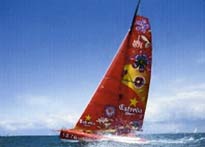 |
 |
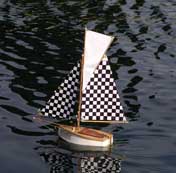 |
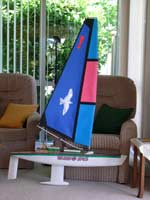 |
Without a doubt, International yacht racing attracts sponsors who often pay huge sums of money in order to sponsor events or sponsor individual yachts, and purely from observation, comparatively few in my opinion appear to take their involvement to the extent of making the boat they are sponsoring, both colourful and distinctive in appearance, I guess the trouble being that that often there are several other sponsors of the same boat each seeking their identity pound of flesh. Look above and here is the boat (a Farr Open 60) sponsored by the Barcelona brewery producers of Estrella Damm beer that has done it so well What an exciting visual impact I am sure many will agree, and a lesson to be learned perhaps, by other International racing yacht sponsors. Turning to the sailing model scene, here is a colourful little Footy with it’s chequered flag material jib and mainsail. Called Tuty Futy it was built and is owned and sailed by Ken Horton of the fun sailing group in Sheffield, England. Then we come to the writer’s Fun Fellow, Island Spice mainsail used when winds are stronger in Auckland, New Zealand.
They all make sail statements and are to a degree examples of `art on the water’.

There have been many boats called Sea Witch, I know that much but the original Sea Witch, launched at Blackwell in 1848 for the China tea trade was rigged as a barque and she lasted until 1883. The model of this Sea Witch shown above is 52” long and was started by someone who never finished her, then completed by my friend Tony Lench and then sold to and sailed by Barry McCready of Kent in the UK. Not a good photograph I’m afraid and where is the model now I wonder? If she is around still she would be some fifty to sixty years old. Built plank on frame and fitted with two channel radio, according to Barry who was a great fan of this type of boat, the model sailed beautifully particularly in a stiff breeze.
I heard from Milton, a chap in New Jersey, USA about a car bumper sticker he’s seen that reads `Life’s too short to own an ugly boat’. (I wouldn’t know for all my boats are pretty – in my eyes anyway! – Ed)
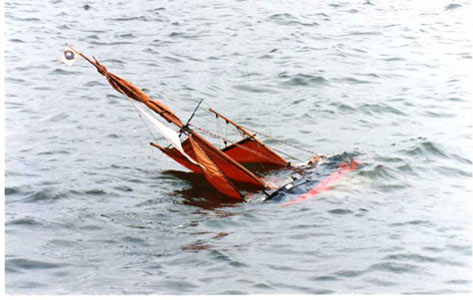
BREAKING NEWS - The Thames Barge GASTON VA4 (formerly the Serenie went down off the East Yorkshire coast of Britain in forty metres of water recently and was declared lost. It was reported that she was apparently sailing without her forward hatch securely closed while carrying a consignment of fifty thousand hard-boiled, unshelled eggs for a Convention of egg lovers aiming to set some sort of world record . It has been reported that a fork lift machine also on board may have rolled on the egg boxes as the waters above revealed a quantity of floating eggshell. The two man crew escaped before the barge rolled and one Robert `Bacon’ Bamford who was in charge was said to have egg on his face when picked up and rescued by helicopter from which this photograph was taken. All `bull this story and a bit `eggy’ some might say but we must exercise the imagination engine topside, loosen up a bit.! I am telling a bit of a `porkie’ here – the sinking of Poole, Dorset model yachtsman, Tony Searle’s model barge Serenie did happen!

The SV DENIS SULLIVAN is a 3 masted, 137’ recreation of a 19th Century Great Lakes schooner. Owned and operated out of Milwaukee by Pier Wisconsin
The vessel is used for both science education and nautical training and is extensively cruised even as far as the Caribbean. Named in memory of Captain Denis Sullivan, an Irishman born in 1849 who commanded the schooner Moonlight for eleven years, he died in 1918. The RC model shown was built by Dan Sullivan seen in the second photograph, both images approved for use here by Jeffrey W Churill of the Great Lakes Modeling Association. Jeff is webmaster of the association and maintains the excellent website well worth visiting www.greatlakesmodeling.com
The model is built to 1/32 scale, has an electric motor, the hull was fibreglassed in two halves, all sails are operated from one servo and it took Dan 700 man hours and one years work.
 |
 |
Abel the windling bear has suddenly got serious and announced he is mounting a challenge for `that’ cup. A `sindickit’ (as he refers to it) is being considered and he has got the cap and practice boat but now needs `greenbacks’, and plenty of them! No strange-to-Abel’s-eyes foreign notes or coinage, nor Monopoly money, heavy Ivory Coast Zangabaloney `hunkas’, Aussie crocodile teeth, near to invisible solid gold fleas or `priceless’ hand-polished Spanish bull ticks, and definitely no Malawi kwachas or Ungaboozi jungle beads picked off the Koonka tree! This is `seryus stuff’ and both Bertarelli and that Larry fella better watch out. Hey Abel aint stoopid you know, that’s not his `cup’ boat! (All this is of course dependent on the two large rich players eventual agreement on fixing fair rules. What a schemozzle! Ed)
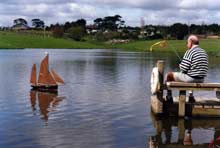 |
 |
Windling ranks with one of the very few simple pleasures left in life and therefore, perhaps it is timely to remember Oscar Wilde’s statement. Carried out on ones own or in the company of others who are like-minded, and accepting of the vagaries of the wind that calls on practitioners of the art to be both peaceful and patient, few will fail to find it a relaxing and refreshing experience.
In the Netherlands, three Optimist dinghy models keep company, the photograph I believe taken by Hans Staal, below that left, a Robbe model of the schooner Valdivia with builder/owner, Robin Harker and over on the right, a Thunder Tiger Victoria called Fear Knot, owned and sailed by Dave Klingman of the Clearpoint Model Yacht Club in the USA, it’s name as enterprising as its somewhat stunning paint job.
 |
 |
I know that the name Ron Rule appears often in this column as I share photos of the new boats of this man who `lives to build them and then sail them’, and keeps producing examples that nobody else would think of. About a month ago the writer (in total jest) took down to the pond a curved piece of much weathered bark that had fallen off the palm tree in the front of his home in Auckland, New Zealand then gave it to the man in question. End result just a few weeks later, the Rule-built Palmir (Palmir get it?) emerged out of Ron Rule’s car at the Onepoto pond. With its hull made of the same bark (and how I wish I had taken a photograph of the original!) and with two channel radio, the little schooner was launched on Thursday 15th May much to the consternation of fellow Ancient Mariners accompanied by a barrage of instant plaudits. Model sailing boat groups need the likes of such a builder who shows what can be done and constantly surprises.
A fitting item to close off this September column.
|

